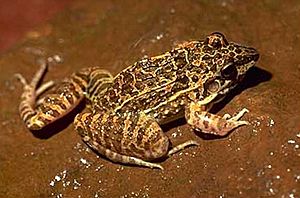Leptodactylus fuscus facts for kids
Quick facts for kids Leptodactylus fuscus |
|
|---|---|
 |
|
| Conservation status | |
| Scientific classification |
The Leptodactylus fuscus is a type of frog that belongs to the Leptodactylidae family. People sometimes call it the rana picuda (which means "woodcock frog") or the rana silbador (meaning "whistling frog"). These names come from its unique look and the sounds it makes.
This frog is found in many countries across South and Central America. You can find it in Argentina, Bolivia, Brazil, Colombia, French Guiana, Guyana, Panama, Paraguay, Peru, Suriname, Trinidad and Tobago, and Venezuela. It's a very adaptable frog, meaning it can live in many different places.
Contents
Where These Frogs Live
Leptodactylus fuscus frogs are very good at living in many kinds of places. Their natural habitats include dry and wet forests, both in lowlands and on mountains. They also live in dry and wet savannas, which are like grasslands with scattered trees.
These frogs can be found in different types of shrublands, which are areas with many bushes. They also like grasslands, especially those that get wet or flooded during certain seasons. You might even spot them in swamps or near freshwater lakes.
They are also comfortable living near people. This includes pastureland (where animals graze), plantations, and even rural gardens. Sometimes, they live in urban areas or in places where forests used to be but are now changed by humans. They can also be found near ponds, irrigated farms, and even in canals and ditches.
What They Look Like
Leptodactylus fuscus frogs are usually medium-sized. They have a pointed snout, which is why they are sometimes called "woodcock frogs." Their skin color can vary. It often helps them blend in with their surroundings. This camouflage helps them hide from predators. Like many frogs, they have strong back legs. These legs help them jump far and quickly.
What They Eat
Like most frogs, Leptodactylus fuscus are carnivores. This means they eat other animals. They mostly eat small insects and other tiny creatures. Their diet can include beetles, ants, spiders, and other small invertebrates. They use their long, sticky tongues to catch their prey. They are important for controlling insect populations in their habitats.
Life Cycle and Reproduction
The Leptodactylus fuscus frog has an interesting life cycle. Like many amphibians, they start their lives in water. The female frog lays her eggs in a special foam nest. This nest floats on the water or is placed near it. The foam protects the eggs from drying out. It also hides them from predators.
After the eggs hatch, tiny tadpoles emerge. These tadpoles live in the water. They breathe using gills, just like fish. Tadpoles eat tiny plants and algae in the water. As they grow, they begin to change. This process is called metamorphosis. They grow legs, their tails get shorter, and their gills change into lungs.
Eventually, the tadpoles transform into young frogs. These young frogs then leave the water and begin to live on land. They will continue to grow until they become adult frogs. Then, they can start the reproduction cycle all over again.
Why They Whistle
The name "whistling frog" comes from the sounds these frogs make. Male Leptodactylus fuscus frogs make calls to attract females. These calls can sound like whistles or chirps. Each frog species has its own unique call. This helps frogs find mates of their own kind. These calls are often heard during the breeding season. They are especially common at night or after rain.
Conservation Status
The Leptodactylus fuscus frog is not considered to be in danger. The IUCN (International Union for Conservation of Nature) lists it as "Least Concern." This means that there are many of these frogs in the wild. Their numbers are stable. This is good news for this adaptable species. It shows they are doing well in their wide range of habitats.
See also
In Spanish: Leptodactylus fuscus para niños


